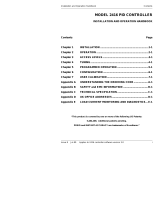
14
Refer Table 6.1 for the parameter descriptions and settings.
CONTROL PARAMETERS : PAGE-10
Section 6
Table 6.1
User Manual
OmniX+
Parameter Description
Settings
(Default Value)
(Default : PID)
On-Off
PID
HYSTERESIS (For On-Off Control only)
Sets differential (dead) band between On-Off switching of the
control output (Relay/SSR).
CONTROL MODE
Select appropriate Control Algorithm suited for process
requirement.
On-Off
The control algorithm tends to maintain the Temperature at SP by
either switching the output fully OFF or fully ON. The On and Off
switching is differentiated by the user settable ‘Hysteresis’.
PID
nd
The control algorithm uses a 2 order equation to compute the ‘%
Output Power’ required to maintain the Temperature at SP. The
constants P, I, D are automatically set by the controller by issuing
Self-Tune command.
1 to 999
or
0.1 to 99.9
(Default : 2 or 0.2)
CYCLE TIME (For PID Control only)
For time-proportionating PID control, the output power is
implemented by adjusting the ratio of ON : OFF time of a fixed time
interval, called ‘Cycle Time’.
Larger Cycle Time ensures longer Relay/SSR life but may result in
poor control accuracy and vice-a-versa. The recommended Cycle
Time values are; 20 sec. for Relay and 1 sec. for SSR .
0.5 to 120.0 Seconds
(in steps of 0.5 Seconds)
(Default : 20.0 Sec)
(Default : 0)
0 to 600 Sec.
(in steps of 0.5 Sec.)
COMPRESSOR TIME DELAY
(For On-Off Control only)
This parameter is mainly used for Compressor Load. For
compressor switching it is desired that once the compressor is
switched OFF, there must be some time delay before it is
switched ON again. The switching ON of the compressor should
therefore take place only if both the conditions, that is; the time
delay is elapsed and PV is above the Setpoint, are satisfied.
Set this parameter value to zero if no time delay is required.

























